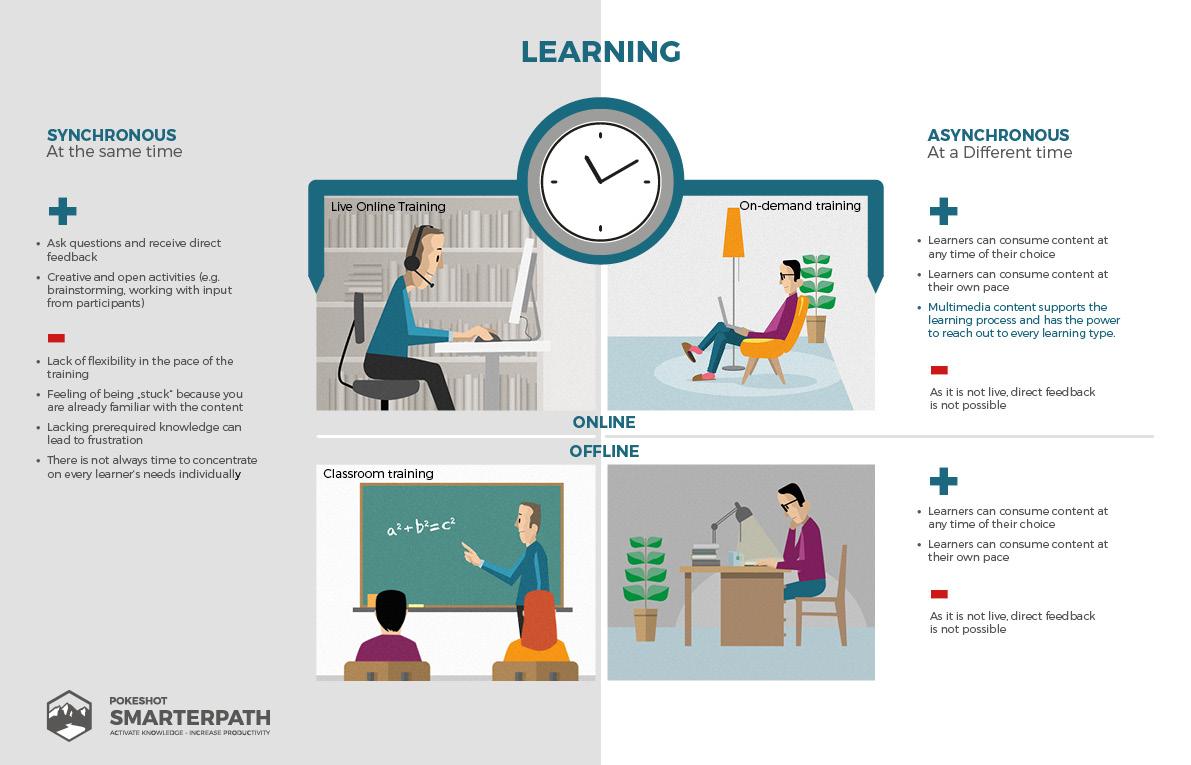This upcoming series of blog articles looks into various kinds of learning, how internet has changed our range of opportunities and asks what the trends are all about.
This first article focuses on the terminology often used in the context of everything around e-learning and offers some clarity: what is behind all those fancy words? The second article looks into various needs and which learning format might fit best for each of them respectively. The third and last article of the series has a look at yet another trend many talk about, which combines social media technoligies and learning management systems.
Sorry, fancy words again – let’s start from the beginning. (Kerstin Schachinger)
Since the 1990s, when the internet became available to the larger public, a lot has happened. Even though this was only around 25 years ago, the internet has moved from being a tool for a few privileged people to being accessible almost all over the world. It has become a huge resource for content, a chance to connect with friends and colleagues worldwide and last but not least has it added new ways of communication and also – learning.
Online learning is trendy, fancy, part of the new digitalized age. But what is it really, that we are speaking about? Is it worth looking into this trend, is the way we learn really going to change in the future or has it changed already? Or is it, as some critics might say, all just a big hype that will pass by soon? In order to answer those questions and to find out whether “this hype” could become relevant to you, we have to start by specifying what it actually is that we mean when we use the term “online learning”.
 share on Facebook | share on Twitter | share on LinkedIn | pin on Pinterest
share on Facebook | share on Twitter | share on LinkedIn | pin on Pinterest
What do I need to know to start the conversation?
There are several terms we need to distinguish within the world of online learning in order to understand what we are talking about. There are scenarios, where trainers and learners interact with each other at the same time (e.g. in seminars, the online version of those are called “webinars”) and other scenarios, where content is provided by trainers at one point in time and consumed by the learners at another point in time (such as pre-recorded video trainings which are available on demand).
What do those 2 scenarios include? What terms do I need to know?
Let’s have a closer look at the differentiation between live trainings on the one hand and on-demand trainings on the other:
| Live trainings (at the same time) | On-demand trainings (at another point in time) | |
|---|---|---|
| Trainer | instructor/moderator | instructional designer |
| Input | prepared and delivered by the instructor/moderator/trainer |
|
| Terminology |
|
|
| Activation of input |
|
|
| Motivation |
|
|
For live trainings, you need an instructor who moderates the session, which is why the term “Instructor-led training” (ILT) has come to use quite frequently. If the live training takes place online, we speak about “webinars”. In a training where all involved stakeholders (trainer, participants) physically share a room, we can use the term “classroom training”. Another option you have is the so-called “virtual classroom”: this scenario connects learners and trainers online inside a virtual room where they can see each other (through a webcam), hear each other (through their headsets) and look at the same content at the same time (e.g. through screensharing or by uploading a presentation).
An advantage of this learning scenario is the opportunity to ask questions and receive direct feedback from the respective trainer. Also, the learning path can be altered flexibly during the training and open, creative activities such as brainstorming or working with input from the participants are only possible if the training is live. One of the disadvantages is the lack of flexibility in the pace of the training: feeling “stuck” in a seminar/webinar because we are already familiar with the presented content is a situation we can all recall. On the other hand, lacking some knowledge which is required for being able to follow the presented content can easily lead to frustration and not always is there the time to concentrate on every learner’s needs individually.
The advantage of on-demand trainings is that learners can consume content at any time of their choice and therefore also at their own pace. The training must therefore be developed in advance which is done by so-called “instructional designers”. There are various forms of on-demand trainings: they can consist of all kinds of content (videos, text, visuals, audio, …) that was either produced for the training or that already existed somewhere else (e.g. a video from YouTube or Vimeo or content from your company’s intranet) and they can involve quizzes (multiple choice, matching, fill in the blank, etc.) which in this format not only measure the learners’ progress but also help to activate the new knowledge by involving the learners.
For example, scenario-based quizzes or check-for-understanding activities are specific ways for learners to both interact with the content and apply their new insigths. Recently it has become increasingly popular to include gamification elements to on-demand trainings which means that learners can collect points for – for example – correct answers and have the chance to compare themselves to fellow learners through a ranking.
The following infographic summarizes the advantages and disadvantages of synchronous and asynchronous learning scenarios:
For sure you have come across some of those scenarios already: which come to your mind? Have you tried online learning yourself and if so, which scenario(s)? Please share your experiences and recommendations: We are looking forward to your comments below!
In the next part of our series we are going to have a look at which formats fit which needs in order to find out, what is the best fit for you.
About the author

Kerstin Schachinger supports the Pokeshot team as a Workplace Learning Consultant. Combining experiences in adult education in Vienna and Berlin with her enthusiasm for training and her love of creating great content, she found instructional design, facilitating workshops and conducting webinars to be her favorite areas to work in. Kerstin’s linguistic background allows her to break down information and communicate complexity in an easy way, an essential skill when creating learning experiences for a wide variety of target groups.
Connect with us on facebook | twitter | LinkedIn | YouTube – we will keep you posted!